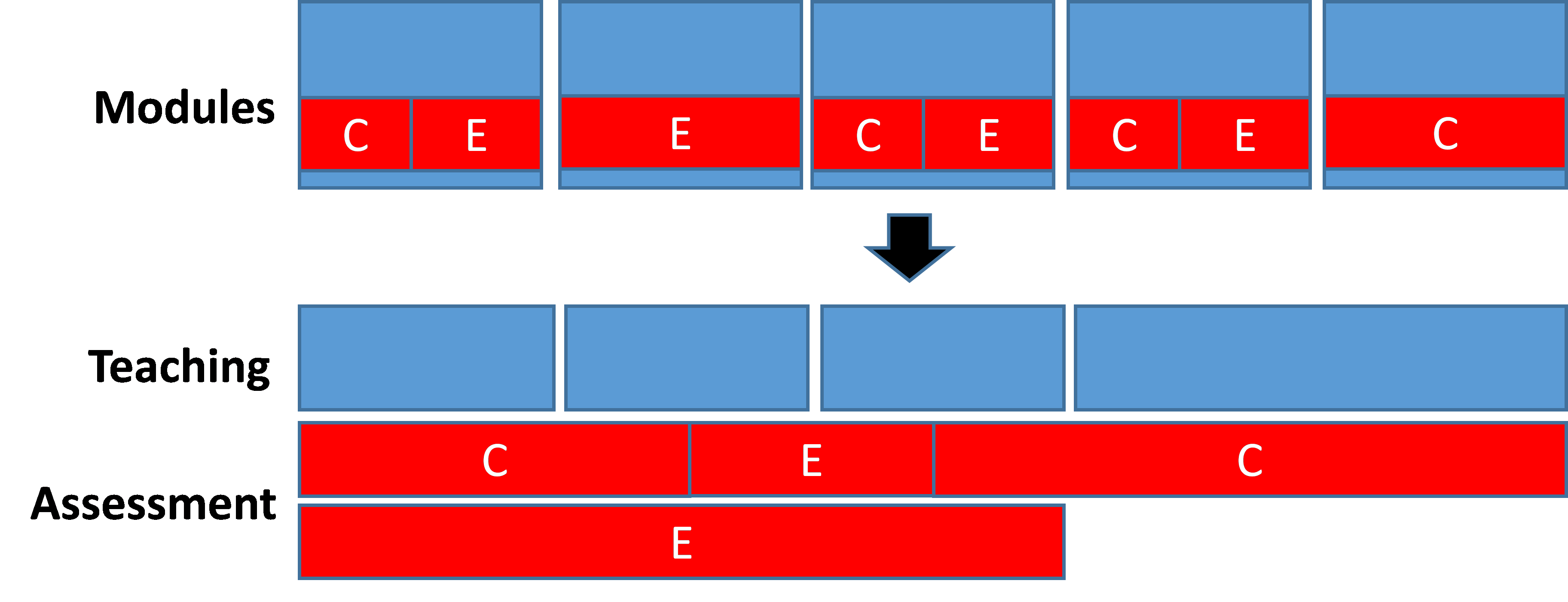About Integrated Programme Assessment
Integrated Programme Assessment (IPA) focusses at programme level with a holistic and overarching learning and teaching strategy underpinned by authentic and synoptic assessments.
Sector context
The move to modular programmes and introduction of a credit accumulation and transfer system (CATS) in the 1990s/early 2000s were intended to increase flexibility and student mobility within and between institutions. It is generally accepted that CATS has failed to stimulate demand for movement between institutions (Souto-Otero 2013), and that the focus on modular programmes resulted in unintended consequences, including over-assessment, restrictive assessment practices, a compartmentalised approach to learning by students, and a failure to promote deep learning (McDowell 2012).
The problem
We wanted to:
- eliminate the compartmentalised approach to learning experienced by students on modular programmes
- reduce the assessment load for staff and students
- improve employability skills and discourage their silo and strategic approach to assessment and learning
The solution
Separating study and assessment (Figure 1) allowed us to pursue a holistic and over-arching teaching strategy using constructive alignment (Biggs 1996), where topics are explored in lectures, seminars and laboratory sessions. Students’ knowledge and understanding are probed through a range of formative activities that support fewer summative assessment tasks which are progressively complex, and:
- are authentic, challenging and relevant; encouraging reflection, integration and application of information;
- test subject knowledge; data analysis and interpretation skills; presentation and communication of scientific material;
- allow staff time to produce better quality feedback

Figure 1: Schematic representation of restructuring Coursework (C) and exams (E).
Outcome
IPA ensures that students are able to demonstrate application and integration of knowledge through meaningful assessments, giving them the skills needed for further study/employment.
The provision is coherent with clarity of how carefully designed assessments relate to learning outcomes;
All students demonstrate achievement of learning outcomes through authentic assessments focussing on skills;
Assessment load is reduced by >60%, providing time and space for formative activities and feedback;
All staff are part of the team, resulting in students experiencing programmes and not a collection of modules.
External validation for this approach has come from External Examiners and PSRBs, and “the synoptic approach to learning, teaching and assessment” was cited as Good Practice by the QAA.
Impact
The impact of IPA is seen in improved KPI metrics between 2013 (pre-change) and 2015 (all graduating students followed new assessment structures):
- NSS scores for Assessment and Feedback and Personal Development increased from73 to 79% and from 82 to 87%, respectively, and the national subject ranking (2016) for Biosciences is 5th for Assessment and Feedback and 3rd for Personal Development;
- Students achieving good degrees increased by ~15%;
- Graduate-level employment increased by 18%;
- Students feel better prepared for employment
“I have to deliver presentations, communicate with clients at face to face meetings, deliver training - all of which require good oral presentation skills and some degree of confidence. Posters and presentations are great practice for that, in addition to being good practice at presenting information visually in an easy to read and attractive manner.
Talks and the 'conference style' poster presentations were also really good for developing networking skills, something that's come in really handy being in a client-facing position”.
Student quote (2015 graduate)
References
Biggs J (1996) Enhancing teaching through constructive alignment. Higher Education 32, 347-364
McDowell L (2012) Programme Focussed Assessment – A Short Guide.
www.pass.brad.ac.uk
Souto-Otero M (2013) Review of credit accumulation and transfer policy and practice in UK higher education. HEA report.